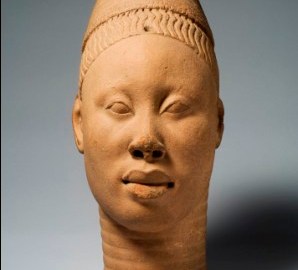Out of Africa: Dynasty and Divinity at the British Museum

For many people, even those most enlightened when it comes to art and culture, Africa remains “the dark continent” out of which little emerges that sparks interest. The Museum for African Art, set to open in 2011 in New York City, hopes to shine new light on the ancient art of Africa and establish that tradition as just as rich, diverse, and important as those more familiar to the Western world. Featuring more than 100 bronze, terra-cotta, and stone sculptures created between the ninth and fifteenth centuries, Dynasty and Divinity: Ife Art in Ancient Nigeria kicks off this effort to bring a taste of the majesty and magic of African art to the west while simultaneously drawing in the imaginations of the intellectually curious who have always wanted to pierce to the heart of the darkness surrounding a continent and its people.
Currently running at the British Museum until the Museum for African Art opens its doors in 2011, Dynasty and Divinity establishes Nigeria as a source of technically sophisticated and spiritually moving ancient art as striking as that of Ancient Greece or Rome. “While Yoruba-speaking people [living in Nigeria] today may be devout Christians or Muslims,” Enid Schildkrout writes in the catalog, “they still tell or talk about—and many hold sacred—the stories, songs, works of art, and shrines that allude to the characters and activities of deified ancestors.” Whether portrait heads of royals or grotesque depictions of monstrous figures, the art of the Ife shown in Dynasty and Divinity demonstrates why people still talk about—and believe in—these stories and ideas centuries later.
The Head called “Lajuwa” (shown) stands as a perfect example of the staying power of these myths become mythic art. The Lajuwa of legend was a servant who usurped the throne upon his master’s death by donning the ruler’s clothing. Once found out, Lajuwa was beheaded, which makes this freestanding, life-sized head seem ironic in conception, as if the sculptor decided to behead the treacherous servant once more. Today, palace servants consider Lajuwa a kind of patron saint, despite (or maybe because of) his treacherous ways. Holes in the sculpted head hint at where a crest or feather may have been inserted. A visible pride washes over the face of Lajuwa, with just a hint of defiance about the lips. The paradoxes and inconsistencies of characters such as Lajuwa found throughout Ife history place them on a par with the fickleness of the Greek gods themselves, and make them just as human and compelling today as they were in ancient times.
I freely admit my ignorance of ancient African art, which made the educational elements of the catalog even more interesting to me. Dynasty and Divinity provides a crash course not only in the particulars of who, what, and when in Nigeria, but also sets out a template for additional investigations into African art, which require an openness to the diversity and difference of encountering a “new” culture, but also an open mind to recognize the similarities that demonstrate just how similar we truly are. By using maps and photographs of the traditions still followed by the descendents of the Ife, the catalog walks you through the basics before getting into the grand particulars. I can only imagine how an inquisitive African-American youth would feel upon taking into his or her hands the catalog of this exhibition and reclaiming a past that was ripped out from under their ancestors’ feet. If Dynasty and Divinity is any indication, The Museum of African Art should quickly take a place of prominence in the education of the American public in terms of art and life, and how the two have always been connected.
[Image: Head called “Lajuwa.” Ife Palace, Ife. 12th-15th century C.E. Terra-cotta. © National Commission for Museums and Monuments, Nigeria. Photo Courtesy Museum for African Art/Fundacion Marcelino Botin. (Photo: Karin L. Willis.)]
[Many thanks to the Museum for African Art for providing me with the image, press materials, and a review copy of the catalog for Dynasty and Divinity: Ife Art in Ancient Nigeria, which will be one of their inaugural exhibitions when they open in 2011.]





